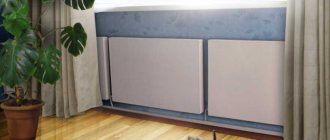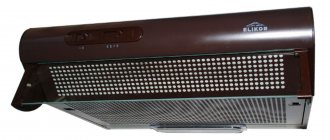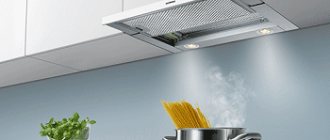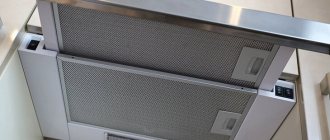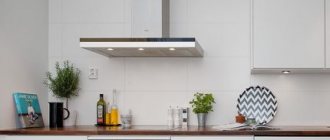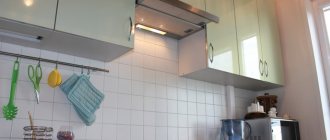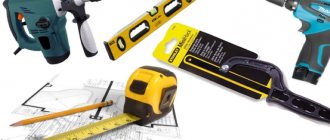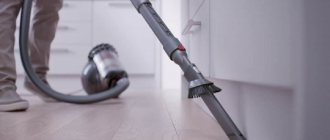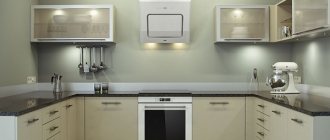When choosing a ventilation device, people often pay attention only to the design of the unit or the brand. But they forget about the most important parameter - the power of the kitchen hood (performance). Without the correct selection of this parameter, even the most beautiful unit from a well-known company will not be able to cope with its task of effectively purifying the air in the room. The performance indicator determines how much polluted air the device can pass through itself in a certain time; it is measured in m3/h.
Types of kitchen hoods
Exhaust devices are divided into several types according to their method of operation, design and mounting option. The type of device often determines the degree of its performance, so at the first stage of selection, it is worth remembering this pattern.
- Flow-through hoods are models equipped with a dome that remove polluted air into the general ventilation system through the chimney. Such hoods can have quite high power.
- Recirculation hoods are compact hoods, the operating principle of which is to pass air masses through a system of cleaning filters. These models, as a rule, have less power than flow-through ones; they pass a limited volume of air through them.
The rules for calculating performance for different types of hoods are slightly different. In a recirculation system, the main factor is the power of the motor, and in a flow-through system, the efficiency of air removal into the ventilation shaft.
The consequences of poor ventilation in the kitchen
Poor ventilation or its absence in the kitchen leads to unpleasant consequences associated with both kitchen appliances and appliances, and the health of the residents:
- Surface contamination. During cooking, large amounts of steam containing fat are released into the air. It settles on kitchen appliances, appliances, furniture, walls and ceilings, leaving a sticky layer that is difficult to wash off.
- Mold formation in hard-to-reach places. Kitchens with poor or no ventilation usually experience high humidity. This has a beneficial effect on the appearance and development of various types of fungi, which spread at high speed.
- Deterioration in health. Lack of fresh air causes headaches, nausea and general weakness.
- Development of diseases . During the cooking process, fat and gas combustion products enter the air. Their constant inhalation contributes to the development of diseases of the respiratory and cardiovascular systems.
Formula for calculating the performance of a recirculating hood
The standard calculation of the required performance of a kitchen hood is carried out using the following formula:
where: N - design capacity, m³/hour; S—kitchen area, m²; h – ceiling height, m; 12 - air exchange rate adopted by SES; 1.3—minimum reserve ratio.
Hood performance calculator
Kitchen area, m²: Ceiling height, m: Air exchange rate: Minimum reserve coefficient:
The universal formula allows you to calculate the parameters under the following assumptions:
- when using an electric stove;
- kitchen with closed doors and windows, separated from other rooms;
- The shape of the room is rectangular.
It is important to note that the calculation formula allows you to find out what volumes of air the device will process at maximum power and operating speed. Of course, in real conditions the device cannot constantly operate in the most energy-consuming mode. To obtain a more accurate result, it is recommended to add 15-20% to the final figure, this way you will calculate the performance of the kitchen hood for efficient operation in medium mode.
If a gas stove is used for cooking, then the coefficient of 12 should be changed to 20 without hesitation. In this case, in addition to fumes, ventilation will also have to remove gas combustion products from the kitchen. If the design has a carbon filter, it is worth adding 20 to 30%, since it creates additional resistance for the incoming air.
Hob type
The type of stove determines how much pollutants can be released into the air during cooking. And updating it, accordingly, should occur more often or less often. The refresh rate must also be changed. The calculation of power for the kitchen when using an electric stove differs from the standard one, since no combustion products enter the air, except for fumes from the food being prepared. The coefficient for such slabs can be increased from 12 to 15, and the formula will look like this: Q=S*H*15.
Hood over electric stove
When you are going to use a gas hob, the coefficient should be increased to 20. This is done so that, in addition to fumes from the food being prepared, a large amount of harmful gas combustion products enters the atmosphere. In this case, the formula is written as: Q=S*H*20.
Hood over gas stove
Calculation of the performance of a flow-through exhaust system
Calculation of the power of an exhaust hood with an air duct is also carried out by calculating the volume of air masses in the room. However, the performance of such a system is greatly influenced by the throughput of the duct. If the air exhaust duct is not installed correctly, the high-power appliance will not operate efficiently and may even fail. Frequent problems that arise are high noise levels and overheating of the electrical parts of the device.
In almost all apartment buildings, air ducts do not exceed 12–13 cm in diameter. Up to 400 m³ of air can be removed through them per hour. This figure should be taken into account when choosing a hood for the kitchen - if you buy a device with a higher performance, the power consumption will increase with a slight increase in productivity.
An important factor is the length and shape of the chimney pipe. If the exit to the ventilation shaft is too far from the installation site of the hood, and the channel itself has unevenness and angles, the air will pass through it at a lower speed. In this case, installing a powerful exhaust device is also unjustified.
Additional functions
It would be logical to consider all possible additional functions that the hood can be equipped with. So, among them:
- residual fan stroke , when even after turning off the hood it runs for another 10-15 minutes to completely clean the air of combustion products, odors and grease particles;
- Interval activation of the hood allows it to turn on once every few hours for 5-10 minutes, even if you are not currently cooking anything or are not in the kitchen at all. This is necessary to ensure constant air purification and fresh air flow into the room;
- The timer allows you to set the time after which the hood will turn off;
- intensive mode complements all present operating speeds, which can be from 1 to 15. It can be activated when there is a strong smell in the kitchen, for example, something burnt. This function can be activated independently in some models;
- Almost every hood has built-in lighting It can be an excellent addition to an existing lighting system in the kitchen. Such built-in lamps can illuminate the area above the stove very well. The number of lamps, as well as their type, may vary. Thus, incandescent lamps, halogen lamps or LEDs can be used. In the most advanced models, the brightness of the lighting can be adjusted over a wide range. to change the focus of light altogether : illuminate only the hob or create diffused light in a certain part of the kitchen;
- remote control Not all models are supported. The simplest option is control using a remote control. More modern - using a smartphone or tablet with an installed application. This way you can change any settings, monitor the operation of the hood from anywhere, and even receive notifications about the need to replace the filter or about increased smoke in the kitchen.
How much all these additional functions are needed is up to everyone to decide for themselves, but if you doubt that you will use any of them, then it is better to give preference to a model with the minimum required set of capabilities. As for the built-in lighting, this is really convenient, but the vast majority of kitchen hoods are equipped with a similar function.
Factors affecting power calculation
To calculate the performance of a kitchen hood, the formula is used:
Q=s × h × 12.
Here, only the size of the room, height to the ceiling and air exchange rate are taken into account. This is a correct calculation, but not complete.
In addition to the kitchen area, the following parameters must be taken into account:
- family composition (clean air consumption must meet sanitary standards per person);
- frequency of cooking;
- what dishes are prepared (with fatty broth or healthy food);
- cross-section, length, material of air ducts.
Slab type
Undoubtedly, the area and type of stove affects the performance of the hood. The type of stove affects the amount of waste in the form of scale and burning that gets into the air when frying meat, boiling borscht, or healthy food with only vegetables. At the same time, the flow of fresh air into the room also occurs in different ways. Consequently, the air exchange rate also changes.
Let's take a closer look at how this happens:
- The calculation of a kitchen hood in the presence of an electric stove differs from the classic one, since combustion products do not penetrate into the air, except for steam from cooking food. As a rule, the air exchange rate for these electric stoves is increased in calculations from 12 to 15, while the classic formula will also change as follows:
Q=S × H × 15.
- When a gas stove is used, the air exchange rate increases to 20. This is due to the fact that in addition to evaporation, combustion products in the form of burning, soot, scorch, etc. enter the air space above the stove. Here the formula for calculating productivity will be different: S × H × 20.
- It would be incorrect to state unequivocally that if there is a cooking surface with an area of 65 cm, the hood should be more productive than with a smaller stove of 55 cm. However, logically this can be assumed, because larger hoods process the air mass from a stove of a larger surface. It is simply impossible to completely remove all harmful particles and odors from cooking at low power.
It is important not to make mistakes when calculating device parameters. Calculating the power of a hood is much easier if you take into account the main aspects.
Kitchen location
When calculating the performance of a kitchen hood, the type, area and isolation of it are taken into account. This could be: an apartment in the form of a studio, a kitchen and living room at the same time, a separate kitchen. Also, sometimes an arch is installed in the opening instead of a door, or the door is constantly open, in which case these parameters must also be taken into account.
Here the kitchen, one way or another, is combined with the adjacent room, so the conditions for calculating the performance of the hood increase several times. Thus, when calculating the power of the device, you need to take into account these additional parameters in the adjacent room, thereby fully providing your household with fresh air.
There is an opinion among users that in a small kitchen a low-power hood is sufficient. But in a small room, odors dissipate faster, which means there is a greater amount of polluted air.
Accordingly, in order for the air to be clean, air exchange must occur more often. However, a low-power hood simply will not be able to provide this, or the engine will overheat and sooner or later burn out.
Why do you need power calculation?
The performance of the engine will determine how much exhaust air the hood can replace in an hour, and it is measured in cubic meters. The main task of this device is to eliminate specific odors in the kitchen, as well as timely removal of fat, soot, and fumes that are inevitably present when cooking and frying food.
How to calculate a kitchen hood so that the performance complies with the conditions of SNiP. Having selected and installed a hood of the required power, the costs for it will be compensated over time by saving detergents.
What types of kitchen hoods are there?
Before proceeding to calculate the required power of the hood, you should decide on its type. There are several varieties of these household appliances. The difference between them is not only in design, but also in the principle of operation. This can be either the removal of polluted air from the room or its recirculation after appropriate cleaning.
Dome
The polluted air, after entering the dome of such an exhaust hood, is thrown out by fans outside through a piping system.
Features of dome-type exhaust devices:
- The system requires a minimum of maintenance, but during its operation it requires an influx of fresh air into the room from outside.
- If the kitchen has modern double-glazed windows that do not allow air to pass through, then you may need to open the window while the hood is operating.
- The disadvantages of this system also include quite significant dimensions and complex installation.
- Such hoods are recommended for use in spacious rooms.
- The complex of boxes and corrugated connections must have a minimum of bends that impede the movement of air.
Flat
These hoods are more compact and easy to install. Unlike dome ones, they do not require connection to ventilation ducts, as they work on the principle of air recirculation.
Features of flat hoods:
- They don't take up much space in the kitchen.
- Require regular maintenance: carbon filters responsible for neutralizing odors will have to be changed every 3-6 months, depending on the intensity of cooking.
- Soot and grease are captured by replaceable acrylic or permanent metal filters. The former will also have to be changed regularly, and the latter washed with detergents.
Built-in
It is better to buy built-in models at the stage of planning the overall kitchen interior. For them, you will have to select or specially order furniture in which most of the hood will be placed.
Features of built-in hoods:
- In their design, they are very similar to dome ones, but, as a rule, they are distinguished by greater power and lower noise levels.
- Most of their design will be hidden inside the furniture, so you won’t have to rack your brains about how to harmoniously fit such a hood into the overall composition of the kitchen.
Note! Even powerful dome and built-in hoods will not be able to provide more air exchange than the capacity of the apartment’s ventilation duct.
In most houses, ventilation ducts can provide unimpeded passage of no more than 180 m3 per hour. Therefore, it is preferable to use hoods that operate on the principle of air recirculation or mixed-type devices. Their higher cost is compensated by their independence from the ventilation capacity of the apartment. Also, there will be no need to solve the problem of fresh air entering the room.
Room layout
In order to use the hood effectively, it must be installed correctly. In this case, it is customary to observe the following rules:
- The socket for air exhaust must have a shape and area such that it completely covers the hob. This is necessary to ensure that all exhaust air is removed from the kitchen.
- The lower the pipe socket is located, the more air it can collect. It must be taken into account that if the edge is too close to the stove, it will become very hot. The optimal distance in most cases is 70-90 cm.
- According to current sanitary standards, the air in the kitchen must be renewed at least 11 or 12 times every hour. This amount depends on the power of the hood and the intensity of work in the kitchen. Typically, if the air is changed 9 or 10 times per hour, then the cleaning quality is considered good.
When using a flow hood, all the air removed from the kitchen is usually transferred to a standard ventilation system. In practice, the owners do not arrange for special ventilation, but use the built-in one, which was provided during the construction of the building. In an apartment building, regardless of the size of the kitchen, it is connected to many apartments.
If a large volume of air from the hood is transferred into it, the operation of this system may be disrupted. In such a situation, it is better to use a recirculation type for the room or equip an additional ventilation system to improve the quality of cleaning.
The air purification procedure depends on the layout of the room. In this case, the presence of doors and windows, the shape of the room, the clutter of the kitchen with furniture, the presence of niches or ledges play a role. Each of these circumstances can influence air movement.
Also, in order to choose suitable equipment for the kitchen, it is necessary to take into account the parameters of the existing ventilation shaft, the number of floors, and the location of the building. The quality of the hood is influenced by a large number of different factors that must be taken into account in order to correctly calculate the performance.
It is often difficult to make an accurate quantitative assessment of the impact of additional factors, so in practice, in order to select a hood, it is taken into account by introducing another coefficient into the calculation formula, equal to 1.3. The previously obtained calculated value calculated by volume is multiplied by this value. The additional coefficient can be changed depending on how specific living conditions differ from the most common ones. For this purpose, you can use a specialized calculator.
When calculating the parameters, you need to take into account not only the layout of the kitchen itself, but also the location of nearby rooms. For example, situations are possible when there is no solid partition between them. In this case, the formula for calculating kitchen ventilation should take into account the combined area.
This situation arises, for example, in cases where the kitchen is separated not by a door, but by an arch. It looks nice, but does not interfere with air circulation.
If, when working in the kitchen, the doors to the adjacent room are constantly open, then the operation of the hood affects the general air environment of these rooms. To understand how much power the unit will require, you need to take into account the specific conditions of its operation.
If the room has a small volume, then the concentration of odors in it will be higher. Therefore, in such a situation, you need to choose a technique that is more powerful than what follows from the calculation using the appropriate formula.
How to choose a kitchen hood based on power
External data and additional elements are not the main indicators. In the first place are technical data and volumes of purified air. The hood productivity is calculated in cubic meters/hour, and the power consumption is calculated in kilowatts spent on operating the device. In an hour, the equipment must refresh all the air in the room at least ten times.
The power of the hood depends on its performance. The more powerful the fan, the more air the hood will push through. Traditional power calculations are designed for circulation models. The productivity formula is simple.
You need to multiply the kitchen area by the ceiling height and by a factor of 12. If a gas stove is installed in the house, then the factor is changed to 20. The last figure is the sanitary standard for absorbed cubic meters of air in residential buildings. 20% of the power reserve is added to the finished value.
This formula will calculate ideal conditions for:
- kitchens with small electric stoves;
- closed premises;
- small rectangular room.
If there is an arched opening in the room or the door is always open, then calculations are made based on the area of the corridors.
Devices with an exhaust system require calculation of the air duct cross-section. In panel apartments, the cross-section of the ventilation ducts is 12.5 cm. This is enough to move about 400 cubic meters of air. A hood with a higher capacity will not cope with its task.
High-power equipment has a significant drawback: high noise levels. Most models are equipped with asynchronous electric motors, which are quieter than other household appliances. But if you turn on the hood at full power, the noise will cause discomfort. In a house where there are small children, it is better to install a quiet device. Inclined models have low noise levels and high power.
What affects the minimum required performance of the device?
When choosing an exhaust device with minimum performance, many factors are taken into account, such as the type of hob, the layout of the kitchen space and the location of the air duct.
Hob
To adjust the formula, depending on the type of hob, certain coefficients are used:
- For electric stoves the indicator is set to 1.5.
- When calculating the exhaust power for a gas surface, a coefficient of 2.0 is used. The indicator is due to the presence in the air of not only food vapors, but also gas combustion products.
Thus, the minimum equipment capacity for a kitchen of 12 m² and a ceiling height of 2.7 m with an electric stove is 486 m³/h, and with a gas stove - 648 m³/h. To comfortably use the device in medium performance modes, the kitchen hood should have a capacity in the range of 600-800 m³/h.
It should have dimensions equal to the dimensions of the hob. It is better to choose a device with large widths.
Exhaust system type
If the air ducts are connected to the ventilation duct of the apartment, natural air exchange can be disrupted. A hood placed above the stove will not be able to remove polluted air that accumulates near the ceiling.
When choosing a recirculation system, the performance of the device is of particular importance, because the air does not leave the kitchen, but returns to the room. The pressure of air masses increases when passing through filters, which reduces the performance of the device.
Each rotation of the ventilation duct reduces the system power by 10%. Taking into account the presence of filters in the recirculation system, 30% is added to the calculated capacity of the hood. Even considering the ease of installation of such a system, many apartment owners prefer the option with a tap.
Important! When connecting the hood to the air duct, add a power reserve factor of 1.3. If carbon filters are installed, it increases to 1.7.
When operating the device in exhaust mode, take into account the throughput of the air duct. You can increase the volume of pumped air by increasing the power, but the noise will increase and the electric motor will begin to overheat.
The standard ventilation duct has a diameter of 125 mm. 400 m³/h easily passes through it. In this case, a powerful hood will be ineffective. When calculating the power of equipment for a small kitchen in a simplified manner, you should pay attention to a low-power device. However, for a very small room (9 sq. m.) you will have to choose a model more powerful than the calculated one. This is due to the fact that small rooms are filled with odors faster.
Features of the kitchen layout
When choosing kitchen equipment, pay special attention to the area of the isolated room. It should be limited by doors, windows and walls. If the door to the kitchen does not close, or the room is combined with the living room, the indicators of the adjacent room are added to calculate the area. The result is a larger number, for example, 20 square meters. m.
Since cooking odors spread quickly, the performance requirements of a kitchen hood increase dramatically when multiple rooms are combined.
Dependence of noise level on performance
As power increases, the noise level of the operating system also increases. If it is too high, the person in the kitchen gets tired quickly, which leads to a deterioration in his condition and the quality of the food.
Modern equipment produces noise in the range of 40-45 dB. In household hoods, asynchronous motors are installed, which are much quieter than many vacuum cleaners and drills. However, the sound of the device begins to cause discomfort when the performance mode is increased.
The best option is to purchase a hood with adjustable power. It will not be possible to find a completely silent device, despite the efforts of the developers of modern climate control technology.
Important! To reduce operating noise of exhaust equipment, it is regularly serviced. Filters and air ducts require timely cleaning.
To remove odors from the kitchen, exhaust equipment with optimal power is selected. They take into account the area of the room, the type of stove, and the features of the ventilation system. It is important to consider the main factors so as not to buy a more powerful but ineffective device.
What to pay attention to
When selecting a device, first of all, you need to find out whether there is a possibility of connection to exhaust ventilation. If the room has this throughput channel, it’s very good. If there is no possibility of connection, you will have to purchase a hood with special filters built into the device.
Hood type
Devices are divided according to the principle of operation, and more specifically, according to the method of removing air flow from the hob.
There are two types of exhaust devices:
- flow-through;
- recirculating
- The first type of device is designed to connect it to a ventilation duct and discharge exhaust air outside. Moreover, such hoods can be combined. They can remove the air flow to the street, or they can immediately return it back, after passing it through filters.
Such modes are chosen at the will of the owner; generally, the second option is convenient to use in winter, so as not to cool the kitchen with the flow of cold air during replacement. Before connecting the hood, you need to check the draft in the channel; to do this, just bring the flame of a candle or match to the hole and make sure whether it deviates towards the channel.
If the draft in the well is weak, then you need to clean it first, otherwise the hood will not fully cope with its task. Another option is to move a separate ventilation duct outside with further insulation.
- The second type , recirculation, is equipped with a filter system, and such devices do not need to be connected to the ventilation duct. In these hoods, the purification of the air mass takes place in two stages. First, mesh filter elements remove particles of fat, burning, and scale.
Then the air mass undergoes a second cleaning through activated carbon, after which all unpleasant odors disappear and then the air returns back to the kitchen. During operation of the unit, filters provide resistance to air circulation, and this must also be taken into account when calculating performance. It is recommended to increase the indicator for such units by approximately 20-30%.
Noise level
When purchasing a hood for your kitchen, you need to pay attention to its noise level, since the sounds produced by different household appliances can cause your discomfort. How to find out the noise level from the installed device? This indicator is indicated in the instructions from the manufacturer. Modern hoods have a noise value from 30 to 70 dB.
An acceptable indicator according to SNiP is considered to be a level from 30 to 45 dB. If the digital value of the hood is higher, its operation will be loud. The more massive the walls of the exhaust device body, the quieter it will work, since all sounds will be absorbed inside the device.
Sometimes manufacturers soundproof the outside of the unit using various sound-absorbing materials. And also in some models, instead of one, two fans with lower power are built-in, which significantly affects the overall noise level towards a decrease.
As a result of such design changes, modern hoods have the lowest noise levels.
When choosing a quiet appliance for the kitchen, experts recommend paying attention to the following aspects:
- Performance. The more powerful the device, the more efficiently it will move the air. Therefore, it will create more noise when operating this way. Therefore, you should not purchase a hood with a power exceeding that calculated for a given room.
- Number of operating modes. Choose a kitchen hood with several modes. This way you can reduce noise by setting the process to a minimum value. When choosing, you do not need to buy a model with a noise level greater than 45 dB.
- Noise level value. Periodically clean the first stage filters and promptly change the second stage carbon filter elements, since when they are dirty they also significantly increase the noise level.
The most powerful kitchen hoods
Calculations of the optimal extraction power were given above. Now we present the top 5 most powerful models of 2021.
MAUNFELD URANIA 53
The UK company has developed one of the highest quality premium models that has many advantages over competitors' products. At the same time, it will not spoil the look of the kitchen, since it is completely built into it. Despite this, operating the device is very simple and does not cause any inconvenience.
Electronic control is organized using buttons and a display. In addition, you can switch the operating modes of the hood remotely, because it is equipped with a remote control.
As for power, in terms of this parameter Urania is considered one of the best. With a width of only 60 cm, it is capable of purifying up to 1250 cubic meters of air per hour.
It is also worth noting other advantages of the model: the presence of LED backlighting, a timer and four speed modes of operation. In addition, the new model received a perimeter suction system and an automatic ventilation function.
Kuppersberg F660
A fireplace-type kitchen hood, which, while not too expensive, boasts good performance. 900 cubic meters of purified air per hour puts it at a level above other competitors. Working with the model is very convenient. It has simple and intuitive touch controls that make it easy to adjust the operation of the device. You can adjust the hood to suit any conditions - it has five operating speeds.
Other advantages of the model are excellent design, low noise level during operation and the presence of a remote control. In addition, you can set a timer, thanks to which the device will turn on and off automatically.
Elica SPOT PLUS ISLAND IX/A/90
Quite a powerful hood, which at the same time has excellent functionality. The power of the model allows it to purify about 1200 cubic meters of air per hour. The device body is made in a minimalist style. The hood has a timer and an indicator showing the level of filter contamination. It is also worth noting the presence of an anti-return valve and pleasant lighting. Thanks to the presence of a small screen and touch panel, it is very easy to control the functions of the hood. Settings can be selected for a specific user.
It is important to pay attention to the presence of an intensive regime. It can be used to eliminate particularly strong odors that may arise when frying fish. When this option is enabled, the hood quickly purifies polluted air and then returns to standard operation.
Apart from the relatively high cost, it is difficult to note any other disadvantages of the hood. A high noise level is expected at such power.
Weissgauff Aura 1200 Remote BL
A powerful hood, in the development of which almost all modern technologies were used. It is capable of purifying 1200 cubic meters of air per hour. The model is completely built-in, so it will not take up much space in the kitchen and will fit into any design. Among the advantages, it is worth highlighting convenient touch controls and the presence of a remote control. In addition, the hood has the following advantages:
- perimeter suction system;
- efficiency – can work in very large rooms;
- digital display with large display;
- three speed modes and an automatic shutdown timer.
The hood can also operate in recirculation mode. To do this, you need to additionally purchase special carbon filters. The main disadvantage is the rather high noise level, but, as in the case of the previous model, this is due to its power.
Jetair Lilly 60 IX
A fireplace hood with a modern, pleasant design. It is suitable for a large kitchen, as it is capable of purifying up to 1200 cubic meters of air per hour.
In addition, the model has a large number of advantages: the presence of an anti-return valve and a filter contamination indicator, the ability to operate in drainage and recirculation modes. A convenient display and push-button controls allow you to work with the hood as comfortably as possible.
The model has three speed modes that can be configured for specific purposes. The main disadvantages are high noise levels and power consumption.
ELIKOR Onyx 60
The quiet inclined hood has an original appearance. The high level of performance allows you to absorb even the most pungent odors. It has four modes, the highest of which removes polluted air in a matter of minutes. The aluminum filter traps soot and grease. The workplace will be illuminated by two bright lamps. The touch buttons are protected by glass, which ensures flawless gear shifting. The noise level in turbo mode is 59 dB. The 15-minute timer absorbs residual odors after the hob has finished operating.
Faber GLASSY ISOLA/SP EG8 X/V A90
The most powerful island hood on the list. Completely eliminates combustion products, fat and soot. The built-in diffuser suppresses noise and ensures efficiency even with problematic ductwork. It is possible to install additional cleaning filters. The model provides 3 speed modes. The maximum noise level is 68 dB. The design allows the hood to fit harmoniously into any interior. Halogen lamps illuminate the hob. The glass surface can be used as a shelf for necessary things.
Noise level
The operation of a kitchen hood is necessary to clean the air. It should be taken into account that ventilation is forced. This requires constant operation of the electric motor. This not only increases energy consumption, but also creates constant noise.
There is an opinion that the more powerful the equipment, the louder the sound of the running motor. In reality, addiction is not that simple. High-quality hoods can be equipped with low-noise fans that will not irritate residents with constant rumbling.
If the owner does not take care to reduce the noise level, it can affect his health, cause fatigue or headaches. Modern models for improving kitchen air exchange are designed for 35-40 dB. This level is less than, for example, that which occurs when operating a vacuum cleaner. However, as work intensity increases, the noise may become louder.
In order to solve this problem, it is convenient to choose which hood can be adjusted within the required limits. In this case, adjusting the intensity of the fans will keep the noise level within acceptable limits.
Carrying out accurate calculations will allow you to determine exactly how much power you should expect from your new hood. This will avoid overspending on equipment that is too efficient and costly. In this case, you will be able to avoid installing too loud electric motors for pumping air.
Design Tips
1. Do you want the main emphasis in the interior to be on facades and furniture? It would be more correct to choose a built-in kitchen cabinet for a hood or a wall-mounted direct hood. 2. Built-in invisible models and detailed dome designs are suitable for traditional-style interiors.
3. Modern kitchen style is characterized by clear and simple forms and laconic design. Built-in, wall and ceiling types of hoods without additional elements are suitable.
4. The color can be chosen to match the shade of the rest of the kitchen appliances (for example: chrome, white or black).
5. The choice of hood can also be influenced by the surface of your kitchen facades. Based on this, it can be glossy or matte.
Types of hood design
Depending on the design features, mounting locations and shape, the hoods are divided into several groups:
- traditional;
- built-in;
- dome
Traditional hoods
The simplest hood option and, as a rule, the cheapest. Such models are attached to the wall above the stove. Most operate in air recirculation mode, but there are also flow-through hoods. In the latter case, it is necessary to connect them with a corrugated hose to the ventilation duct, which does not add style to the kitchen. That is why they try to hide such a hose in a box or behind kitchen cabinets. Circulating hoods of this type have a lower price, but remember that you will have to spend money on filters.
Built-in hoods
This is a more functional option that is not conspicuous and in no way capable of spoiling the interior. Mount such a hood above the stove in a wall cabinet. Many models are equipped with a retractable panel , with which you can increase the surface of the hood and, accordingly, increase its performance. In terms of price, such hoods are not much more expensive than traditional ones, so it is better to give preference to this option, especially if you buy the device along with kitchen furniture.
Separately, it is worth noting those built-in hoods that are mounted into the countertop , and their intake part is usually retractable. Such models are not cheap and, moreover, take up useful space in the kitchen work area, which is critical for small rooms. For spacious kitchens, this is not such a minus, because the models have a significant advantage - a bold design that does not spoil, but decorates any kitchen. Moreover, such devices are able to catch all contaminants before they rise to the top.
Dome hoods
Such models are able to more effectively capture all contaminants. They can be of the following types:
- fireplace;
- island;
- corner.
Fireplace hoods get their name due to their shape, which resembles a fireplace exhaust system. They are quite large, often have an intricate design, and often it is the design, and not the technical parameters, that increases the price of a particular model.
An island hood can be mounted in absolutely any part of the kitchen, not necessarily against the wall. It is mounted using a ceiling mount and is an ideal option for a spacious kitchen where the work area is located in the center of the kitchen, for example, on an island. The price of such models is not affordable, but in terms of performance and design they are one of the best.
The corner hood has a body shape that allows it to be installed in the corner of the kitchen. Such models are ideal when the room does not have a large area and there are no worthy alternatives. Hoods of this type cope with their tasks normally, but are presented in a small assortment.
Operating modes
Nowadays, it is almost impossible to find devices that operate at only one power (maximum). All manufacturers equip their hoods with an operating mode switch (electronic or mechanical). It allows you to change the fan speed depending on the needs of the owner.
Standard models come with three speeds. In more expensive ones their number can reach 5.
Hood control panel
The first speed helps keep the air in the kitchen clean. It can be turned on on an ongoing basis if 1 dish is being prepared on the stove.
If the housewife cooks on two burners at the same time or bakes pies in the oven, it is worth turning on the hood in the second, more productive mode.
The third, maximum mode should be started if you need to quickly clean the air in the kitchen, for example, when all the burners are occupied or something is burnt on the stove. To enhance the effect and speed up the odor removal process, you can close the door to the kitchen.
Hood operating modes
At the third and final speed, the hood will operate at maximum power. To extend the life of the device, this mode should be turned on from time to time, rather than using it on an ongoing basis.
How is a hood different from ventilation?
In modern apartments, an exhaust hood, better known as a hood, is placed above the kitchen stove. Many homeowners are convinced that this air collector is responsible for the ventilation of the kitchen.
Therefore, with a clear conscience, they lead the ventilation duct pipe from the hood into the ventilation hole, designed and built by the designers of the high-rise building.
What happens if the standard ventilation in the kitchen is blocked by an air duct from an exhaust hood? The intensity of air exchange in the apartment will decrease sharply.
Kitchen hood installers and kitchen umbrella sellers usually state the opposite. They will say: this equipment will significantly improve the quality of air supply at home, because it has a powerful ventilation unit.
However, the power of a stove hood has nothing to do with ventilation. The reason is that the air exchange in the apartments of most residential high-rise buildings, especially those built before 2000, was designed with supply and exhaust ventilation in mind.
The principle of air exchange in a multi-storey building is based on sources of supply air (windows, vents, etc.) and exhaust ducts (Fig. on the left). The latter are displayed vertically through all floors of the building. The kitchen hood can be connected to the duct (picture on the right) or not connected
Street air entered through the cracks in the window frames and the front door. And ventilation ducts in the kitchen, bathroom and toilet were used to remove “stale” air. It would seem – what’s wrong?
The hood in the kitchen is for extracting air. So why can’t you “stick” an air duct from an exhaust hood into it? It's all about air performance.
A kitchen hood not connected to the general house ventilation system discharges contaminated air through a separate ventilation hole or works as a recuperator without the function of removing air masses
Air ducts in residential apartment buildings are designed for a certain load. In general, the throughput of any communications is carefully calculated at the design stage.
And under ideal conditions (clean walls of the ventilation duct, no interference at the entrance or exit, etc.), the productivity of natural ventilation in a high-rise apartment will be 160-180 m3/h.
You may also be interested in the information about the standard air speed in air ducts discussed in this article.
Examples of calculations
Let's look at examples of how to correctly calculate power:
For calculations, let’s take a typical Khrushchev kitchen with an area of 6 m2. The standard ceiling height in such rooms is 2.5 m.
The calculation will look like this:
S=6 m2; H=2.5 m; Q=S*H*12=6*2, 5*12=180 m3/hour
The final figure is the maximum power of the device, which will provide the necessary air exchange.
Let's take an example of a kitchen in an apartment with an improved layout. Its area is 9 m2, ceiling height is 2.8 m2.
The calculation will be as follows:
S=9 m2; H=2.8 m; Q=S*H*12=9*2.8*12=302.4 m3/hour.
It is with this declared power that the hood will ensure effective air purification in the room.
It should be noted that the given power calculator is very conditional. It does not take into account many factors: open doors or windows, a set that takes up part of the volume, an abundance of decorative elements, shelves and niches.
Calculated power table
Complicating Factors
In addition to the listed nuances, the performance of the device can be affected by the installation method and location of the device. Often the hood is located several meters from the ventilation opening and requires the installation of a long duct. To accurately place the pipe over the headset, it has to be turned or bent several times. With each bend, the speed of passage of air masses decreases. Before you finally calculate the hood for the kitchen, you need to add 10% capacity for each bend, for each turn.
Duct with swivel elbows
For example, the estimated productivity of the device is 500 m3/h. If an air duct is connected to the hood, which will be bent at right angles twice before being vented, the calculation will be as follows:
Q=500*1.1*1.1=605 m3/h
The structural features of the ventilation shaft, its contamination and blockage remain hidden from the eyes of the apartment owner. Therefore, in the final calculations, the minimum safety factor is used, which is equal to 1.3. It compensates for the number of floors in the apartment, bends in the air ducts and the passage of the shaft, which affect the loss of hood performance.
Power consumption and performance
When it comes to hoods, buyers often confuse these two concepts. Performance or exhaust power is the volume of air that a device can pass through during an hour of operation. The unit of measurement is m3/hour.
Power consumption is the amount of electricity consumed by the hood motor per hour of operation. It is measured in kilowatts/hour (kW/h).
These characteristics are directly related to each other. The more powerful the engine is that can rotate the fan blades, the higher the performance of the unit will be.
